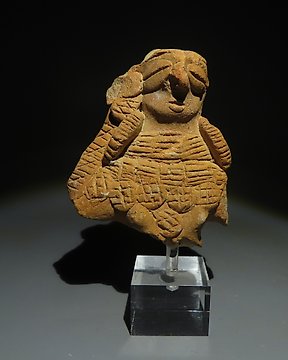
哈拉帕 Terracotta 女神軀幹。西元前 2500-1900 年。 8.5 公分高。 (沒有保留價)
編號 83422407

編號 83422407

Embark on a journey through time with this Romano-Egyptian terracotta figure of Harpocrates, a testament to the mingling of cultures and the enduring legacy of ancient beliefs. Crafted in the 1st century BCE to the 1st century CE, this earthenware piece represents a unique fusion of Egyptian religious tradition and Greco-Roman artistry.
Harpocrates, known as the god of silence, secrets, and confidentiality, is depicted in a youthful form, nude except for his pointed cap, a traditional representation in Hellenistic art. This figurine, standing at 4.3 inches high, shows the deity in a typical pose—finger to lips—signifying silence, a gesture that was misinterpreted by the Greeks and Romans as a call for silence. The snake adorning his shoulders symbolizes royalty and divine authority, reinforcing Harpocrates' significance in the pantheon.
Produced from the dark red-brown Nile silt, this figure's material itself narrates the story of its origin. The Nile's fertile mud was the lifeline of Egypt, pivotal for agriculture and material culture. In this case, it serves not only as the medium for artistic expression but also as a symbol of the divine, as many Egyptian gods were closely associated with the river and its offerings.
The technique of mold-making for terracotta figures like this one was widespread in the ancient workshops of Naukratis, a trade hub near Alexandria. Such figures were intended for domestic use, serving as personal votive offerings or household protectors. Their presence in homes underscores the personal relationship between the Egyptians and their deities, a feature characteristic of Egyptian piety.
The stylistic elements—naturalistic yet stylized—reflect the Greco-Roman influence prevalent in Egypt after Alexander's conquest and during the subsequent Roman rule. The integration of these styles is evident in the fluid lines and detailed depiction, making it a sought-after piece for collectors fascinated by cross-cultural artifacts.
Provenance is a cornerstone for collectors, and this piece boasts an impressive background. Exhibited in renowned institutions like the Minneapolis Museum of Art and the Los Angeles County Museum of Art, and published in scholarly works, this figurine's history is as rich as its cultural heritage. Such details not only authenticate the piece but also provide a tangible connection to the past for the collector.
Considering its provenance, condition, and cultural significance, artifacts like this Horus figure are typically sought after within the collector's market. The pricing for such pieces may vary, reflecting their historical value, artistic merit, and the depth of their provenance. As a guide, comparable items from this era and of similar cultural significance may be valued within the range suitable for discerning collectors who appreciate artifacts with a clear historical lineage and cultural narrative.
Collecting ancient artifacts is not merely an acquisition of objects; it's an embrace of history, art, and spirituality. This Romano-Egyptian figure of Harpocrates, once held in private domestic spaces, now offers a glimpse into the daily life and beliefs of an ancient civilization, making it a remarkable and rare piece to cherish.
Visual Analysis:
The Romano-Egyptian Pottery Horus the Child is a notable embodiment of the cross-cultural artistic synthesis between Egyptian and Greco-Roman styles. The posture of Harpocrates, with the finger to his lips, is a signature motif representing silence. However, what makes this figure particularly interesting is the presence of a serpent, which in Egyptian culture could symbolize protection or wisdom, indicating the figure's likely role as a household guardian or amulet. The earthenware material and the method of production, suggested by the mold-made characteristics, point to the widespread and popular nature of such figures in domestic settings of the period. The piece’s provenance and exhibition history enhance its desirability, reflecting a well-documented artifact with a clear historical lineage.